Attractive celebrities and peers online: What is their effect on our body image?
When you scroll through Instagram or Facebook nowadays you are bound to come across an abundance of images of thin and attractive women. Although we are accustomed to seeing beautiful women in magazines and on television, social media creates a new opportunity for users to be exposed to idealised images of their peers and their favourite celebrities.
In traditional media, celebrities are presented as beautiful and ideal figures for women to aspire to. But how does exposure to attractive celebrities on social media sites such as Instagram affect women’s body image?
Instagram in particular is a unique social networking site because its prime focus is on images. Instagram users can edit and filter their images to achieve an ‘ideal’ look, much like magazines photoshopping their images. However, Instagram is more personal than magazines. It presents celebrities and peers together on the same platform, and potentially makes celebrities seem more like friends. Given the rise of Instagram and the popularity of other social networking, it is pertinent to ask what is the effect of looking at attractive peers and celebrities online? And how does exposure to these images influence our body image?
Research examining the effect of traditional mass media suggests that exposure to images of thin and attractive women has a detrimental effect on women’s body image (Grabe, Ward, & Hyde, 2008; Groesz, Levine, & Murnen, 2001). Additionally, further research suggests that interest in celebrities and time spent on social media both negatively influence women’s body image (Fardouly & Vartanian, 2015; Maltby, Giles, Barber, & McCutcheon, 2005; Tiggemann & Slater, 2014;).
To further examine the effect of attractive celebrity and peer images on body image we conducted an experimental study (Brown & Tiggemann, 2016), asking 138 female undergraduates to view either thin and attractive celebrity images, peer images, or control images. We found that exposure to Instagram images of both celebrities and peers led to greater negative mood and body dissatisfaction.
We also found that the detrimental effect of these images on body image can be attributed to participants comparing their appearance with the appearance of the thin and attractive celebrities and peers. When comparing their appearance to ideal peers or celebrities, most women will inevitably fall short, and consequently feel bad about themselves and their bodies.
It is interesting to note that despite initial expectations, participants compared their appearance to peers and celebrities similarly, resulting in comparable detrimental impact on their body image. Perhaps attractive images have a negative effect on body image regardless of the source (magazines or Instagram) or who is featured (peers or celebrities).
Our final finding was that women who had a higher interest in celebrities (celebrity worship) were more adversely affected by the attractive celebrity images than women who were not interested in celebrities. Therefore, celebrity worship may be regarded as a vulnerability factor for body dissatisfaction and disordered eating.
Our findings, in concert with previous research, demonstrate that constant presentation of thin and attractive women, like those found online and in magazines, reinforces an unachievable thin ideal in women and has adverse impacts on mood and body image. Ideally, it would be advisable to limit our exposure to images of attractive women and reduce our use of social media. However, this is a daunting and perhaps unrealistic ask. Alternatively, educating yourself about the potential dangers of these images has shown some success in combatting their harmful effects on women’s body image (Levine & Murnen, 2009; Wilksch et al., 2015).
Zoe Brown is a research assistant in the School of Psychology at Flinders University. She works with Prof. Marika Tiggemann on researching issues surrounding the effects of media on women’s body image. Together they are currently examining the effect of disclaimer labels on women’s mood and body dissatisfaction.
Fardouly, J., & Vartanian, L. (2015). Negative comparisons about one's appearance mediate the relationship between Facebook usage and body image concerns. Body Image, 12, 82-88. doi:10.1016/j.bodyim.2014.10.004
Grabe, S., Ward, L., & Hyde, J. (2008). The role of the media in body image concerns among women: A meta-analysis of experimental and correlational studies. Psychological Bulletin, 134(3), 460-476. doi:10.1037/0033-2909.134.3.460
Groesz, L., Levine, M., & Murnen, S. (2001). The effect of experimental presentation of thin media images on body satisfaction: A meta-analytic review. International Journal Of Eating Disorders, 31(1), 1-16. doi:10.1002/eat.10005
Levine, M. P., & Murnen, S. K. (2009). "Everybody knows that mass media are/are not [pick one] a cause of eating disorders": A critical review of evidence for a causal link between media, negative body image, and disordered eating in females. Journal of Social and Clinical Psychology, 28(1), 9-42.
Maltby, J., Giles, D., Barber, L., & McCutcheon, L. (2005). Intense-personal celebrity worship and body image: Evidence of a link among female adolescents. British Journal Of Health Psychology, 10(1), 17-32. doi:10.1348/135910704x15257
Tiggemann, M., & Slater, A. (2014). NetTweens: The Internet and Body Image Concerns in Preteenage Girls. Journal of Early Adolescence, 34(5), 606-620.
Wilksch, S., Paxton, S., Byrne, S., Austin, S., McLean, S., & Thompson, K. et al. (2014). Prevention Across the Spectrum: a randomized controlled trial of three programs to reduce risk factors for both eating disorders and obesity. Psychological Medicine, 45(09), 1811-1823. doi: 10.1017/s003329171400289x






Interesting article. Thank you.
ReplyDeleteWonderful post! Consult a skin and hair specialist for better treatment, click Skin Whitening Clinic in East Delhi
ReplyDelete